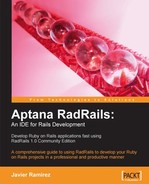0%
14Chapters
0-1Hours read
0kTotal Words
Book Description
A comprehensive guide to using RadRails to develop your Ruby on Rails projects in a professional and productive manner
Comprehensive guide to using RadRails during the whole development cycle
Code Assistance, Graphical Debugger, Testing, Integrated Console
Manage your gems, plug-ins, servers, generators, and Rake tasks
Rails 2.0-ready
Includes a chapter about Subversion and Database integration
Smart Code Assistants for HTML, JavaScript, and CSS
Table of Contents
- Aptana RadRails: An IDE for Rails Development
- Credits
- About the Author
- About the Reviewer
- Preface
- 1. Getting Started
- 2. First Steps
- 3. Your First Application
- 4. Writing Ruby Code
- 5. Coding Rails Views
- 6. Debugging Your Application
- 7. RadRails Views
- 8. Configuration Reference
- 9. Other Useful Plugins
